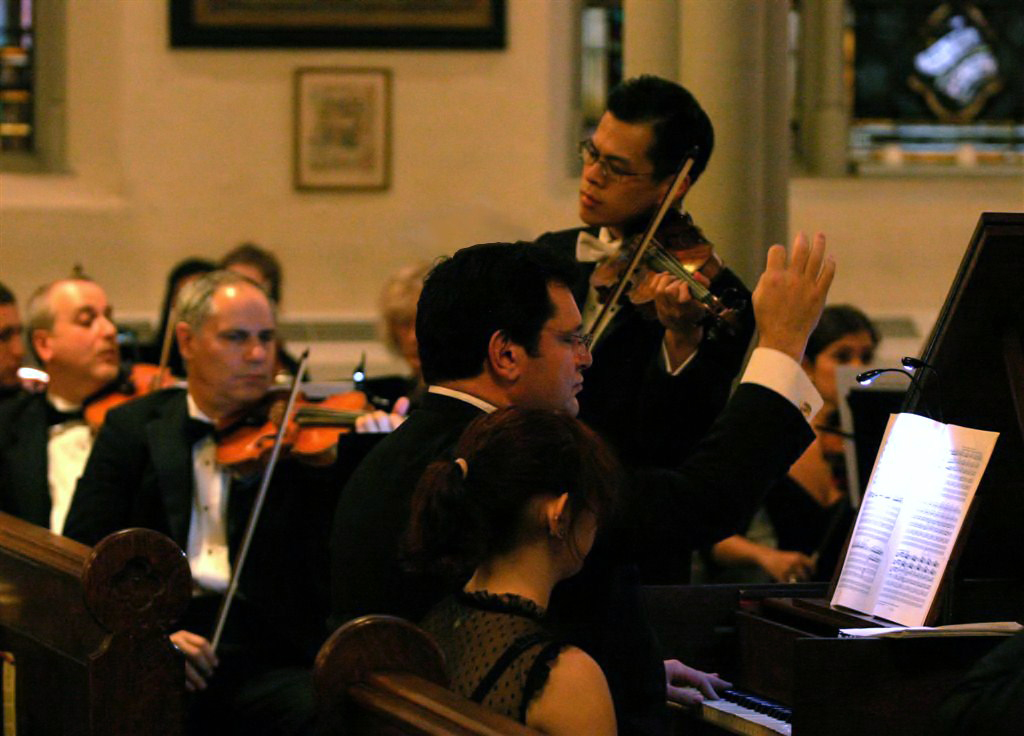The Park Avenue Chamber Symphony in Review
The Park Avenue Chamber Symphony in Review “Baroque Celebration”: Vivaldi’s “Four Seasons” and Gloria David Bernard, Music Director and Conductor David Chan, Violin Florilegium Chamber Choir; Nicholas DeMaison, Director All Saints Church, New York, NY December 12, 2010
David Bernard leading the Park Avenue Chamber Symphony from the harpsichord continuo in Vivaldi’s Four Seasons with soloist David Chan, Concertmaster of the Metropolitan Opera Orchestra. Photo Credit: Claire Stefani
In an all-Vivaldi concert, the Park Avenue Chamber Symphony got in the holiday spirit with the composer’s Gloria in D, RV 589 and his eternally famous “Four Seasons”. The orchestra’s violin soloist was Metropolitan Opera Concertmaster David Chan, who inspired a riveting and stellar performance on all fronts. Music Director David Bernard, who led the performance while playing the harpsichord, did an excellent job of maintaining solid ensemble-playing and consistently driven tempos in what was a crisply articulate, high-energy account. To top it off, there was a brief poetry reading prior to each season, read with poise and clarity by All Saints Church Music Director Cynthia Weinrich; this was a great idea. Chan played at the highest level possible—with both sweet-toned polish and gutsy intensity—bringing a romantic air of expression to the piece, as one should when there is such detailed, innovative tone-painting (musical descriptions) in the music.
Because “The Seasons” was given such a memorable performance, it could easily have been on the second half of the program. And all four seasons (four concertos with several movements each) are in fact longer and more epic in stature than this Gloria. Naturally, one can understand why Bernard chose the Gloria to conclude the concert; choral works with numerous performers—a visual as well as an aural delight—usually do provide for an emotionally or spiritually satisfying conclusion. But since the superior Vivaldi opus and performance was “The Seasons”—I would have preferred the save-the-best-for-last approach and conclude with that work instead.
Bernard conducted the Gloria from memory and with an astute ear for phrasing and color. My peeves were the sometimes less-than-polished solo singing—although soprano Nina Riley sang beautifully—some out of tune trumpet playing, and the fact that The Florilegium Chamber Choir was sometimes tentative and difficult to hear (especially in lower registers). When I could hear them, however, diction was clear and the phrasing was elegant. Principal cellist John Yakubik’s solo playing was also appealing.
Another reason I can see why the Gloria was indeed placed on the second half was because it led nicely to a Holiday Sing Along, in which Bernard placed the chorus antiphonally on both sides of the church. Here, the voices came through loud and clear—although it didn’t hurt that the large audience at hand lent their voices to what was a robust reading of several Christmas Carols. It is a credit to David Bernard that he has such enthusiastic followers in his audience. Usually you can hear it in applause, but this time it was through the music itself.
